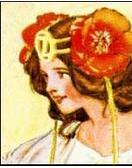 I’ve been wanting to read this for a while, but I knew it would be a tear-jerker and wanted to read it at the right time. I’m not telling you anything, by the way, you wouldn’t know from reading the first chapter.
I’ve been wanting to read this for a while, but I knew it would be a tear-jerker and wanted to read it at the right time. I’m not telling you anything, by the way, you wouldn’t know from reading the first chapter.
Tell the Wolves I’m Home is the story of fourteen-year-old June, whose beloved uncle dies of AIDS in the late eighties. The book vividly describes a time when people were afraid to be in the same room with someone who has AIDS, and very few people knew where it came from or how it could be transmitted. A time when the fear of AIDS meant that those who were afflicted were treated horribly. It was easy to make people with AIDS the scapegoat rather than the victim.
But there’s more to this story. Finn had a close friend, Toby, who the family considers his murderer because he knowingly gave him AIDS. June isn’t allowed to have anything to do with Toby — until he reaches out to her one day after the funeral. Stricken with grief, June is willing to latch on to any little thing that remains of her uncle’s memory, and agrees to meet with him.
What follows is a rich, multi-layered story about grief and friendship and growing up. This is one of those books where, even if I can’t relate to the story in a personal way, I definitely related to the characters. June is a strange, bookish, lonely kid, but one I admired because she’s pretty comfortable with who she is.
I walk and walk until all I can hear are the little cracks and snaps of branches and the swish of the brook. I follow the brook to a place where there’s a crumbling stone wall and a tall maple tree with a rusted-out sap bucket nailed just above head height. That’s my place. That’s where I stop. In the book A Wrinkle in Time, it says that time is like a big old rumpled blanket. What I’d like is to be caught in one of those wrinkles. Tucked away. Hidden in a small tight fold.
In particular, the sibling relationship between June and Greta brought back a lot of memories of my own sisters – the meanness, jealousy, and misunderstandings. As adults we look back and say, why didn’t we support each other more? Why weren’t we closer? Today, my sisters are my closest friends, but as children, we really weren’t there for each other.
While the sisters’ relationship resonated the most for me, there’s so much to think about in this book. It’s a book about loss, and love, and friendship, family dynamics, tolerance and reaching your potential. None of the characters are one-dimensional, including June’s mother. But most important is June herself, who struggles to maintain her individuality but still develop socially as a teenager, and who struggles to understand what it means to love. Finn made her feel special, and without him she doesn’t feel anyone sees her anymore.
This is the second book I’ve read recently where a painting played a major role in the story. This book, like The Goldfinch, raised some fascinating issues about the value of art, what it means, and who owns it.
But throughout, it’s about AIDS, and a time when this disease took the lives of way too many people.
I thought this was going to be a sad weepy kind of book, but it surprised me with its depth and subtlety. It’s not a fast-paced book; the drama is subtle and slow. But it’s worth every minute.

